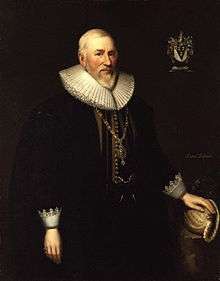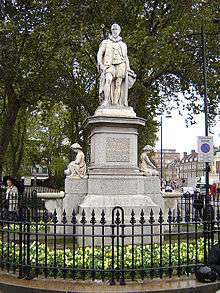Hugh Myddelton
| Sir Hugh Myddelton, 1st Bart. | |
|---|---|
 Sir Hugh Myddelton (1560-10 Dec 1631) | |
| Born | 1560 |
| Died | 10 December 1631 (aged 71) |
| Nationality | Welsh |
| Other names | Hugh Middleton |
| Occupation | entrepreneur |
| Known for | New River |
Sir Hugh Myddelton (or Middleton), 1st Baronet (1560 – 10 December 1631) was a Welsh clothmaker, entrepreneur, mine-owner, goldsmith, banker and self-taught engineer. The spelling of his name is inconsistently reproduced, but Myddelton appears to be the earliest, and most consistently used in place names associated with him.
The sixth son of Richard Myddelton, governor of Denbigh Castle in Wales and MP for Denbigh Boroughs, he travelled to seek his fortune in London and after being apprenticed to a goldsmith became so successful in that trade that he was appointed Royal Jeweller by King James I. In the meantime, he became an alderman and then recorder of Denbigh, and in 1603 succeeded his father as MP for Denbigh Boroughs, which he remained until 1628. He also became a very wealthy merchant and clothmaker.
New River
Myddelton is, however, best remembered as the driving force behind the construction of the New River, an ambitious engineering project to bring clean water from the River Lea, near Ware, in Hertfordshire to New River Head, London. After the initial project encountered financial difficulties, Myddelton helped fund the project through to completion, obtaining the assistance of King James I. The New River was constructed between 1608 and 1613 (being officially opened on 29 September that year), and was originally some 38 miles (60 km) long. It was not initially a financial success, and cost Myddelton substantial sums, although in 1612 he was successful in securing monetary assistance from King James I.
Mining activities
In 1617, Myddelton obtained large profits from lead and silver mines at Bronfloydd, Cwmerfyn and Cwmsymlog in Cardiganshire, Wales. Working those mines involved building aqueducts to serve the stamp mills needed to crush the ore. Following engineering works at Brading on the Isle of Wight, he was created a baronet in 1622.
He died in December 1631, and was buried in the church of St. Matthew Friday Street, London. He had a family of ten sons and six daughters.
One of Sir Hugh's brothers was Sir Thomas Myddelton (c. 1550–1631), Lord Mayor of London, and another was William Middelton (c. 1556–1621), poet and seaman, who died at Antwerp on 27 March 1621.
Memorials
 Statue of Sir Hugh Myddelton by John Thomas, on Islington Green previously known as Paradise Row near the terminus of the New River. Unveiled 1862 by William Gladstone, then Chancellor of the Exchequer and soon to become Prime Minister. Statue of Sir Hugh Myddelton on the Royal Exchange, London |
There is a statue of Myddelton on Islington Green. He has a blue plaque on the site of his former residence at the end of Cunard Crescent in Enfield. Clerkenwell streets, not far from the Round Pond, the original southern end of the New River, and locations and institutions (some closed) named after him include Myddelton Square and Myddelton Passage; Hugh Myddelton Primary School in Myddelton Street; the Myddelton Wing of the LSE Rosebery Hall of Residence, also on Myddelton Street; Hugh Myddelton Secondary school (which closed in the mid 1960s in Sans Walk, Islington); and Myddelton House on Pentonville Road, central office of Citizens Advice. Myddelton Avenue, parallel to Brownswood Road and the site of one of the New River Reservoirs, also takes its name from him. At the northern end of the New River, Myddelton Road in Ware is situated close to the source of the river. Myddelton Road in Bowes Park crosses the New River at a point where it goes underground between there and the Hornsey water treatment works, where there is another Myddelton Road off Hornsey High Street. Bounded by the former course along the valley of Turkey Brook, Myddelton House at Bulls Cross, Enfield (now the headquarters of the Lee Valley Regional Park Authority) was also named in his honour; it was built by Henry Carrington Bowles (formerly a print and map maker of St Paul's Churchyard) whose wife, Anne Garnault, was a member of a Huguenot family with a controlling interest in the New River Company. On an island in the New River at Great Amwell a stone memorial is dedicated to Myddelton. There is a Myddleton Arms on New North Road in Canonbury, curiously with that spelling.[2]
References
- ↑ newriver.pdf at shelford.org
- ↑ Great Amwell memorial urn. Retrieved 30 October 2011
External links
- biography in Science & Society Picture Library
- page 534 of Tallis's Topographical Dictionary of England and Wales, published 1860
- Water-related Infrastructure in Medieval London
- Encyclopædia Britannica Eleventh Edition
- Welsh Biography Online – Myddleton family
- Biography
| Parliament of England | ||
|---|---|---|
| Preceded by Richard Myddleton or John Panton |
Member of Parliament for Denbigh Boroughs 1604–1629 |
Succeeded by Parliament suspended until 1640 |
| Baronetage of England | ||
| Preceded by New creation |
Middleton Baronet of Ruthyn | Succeeded by William Middleton |
